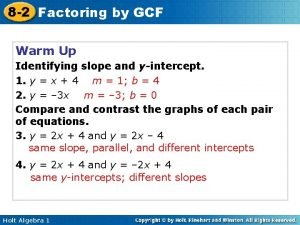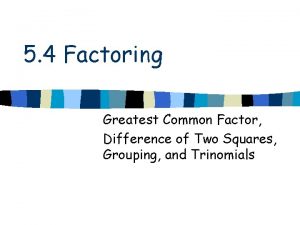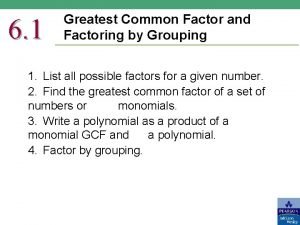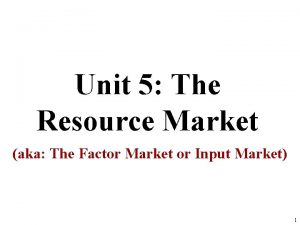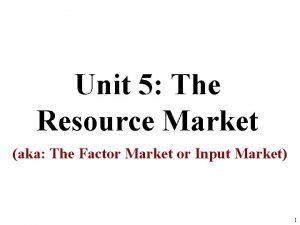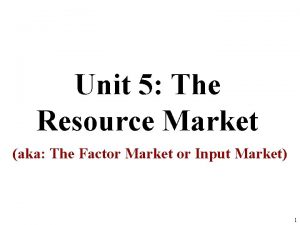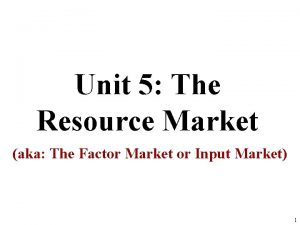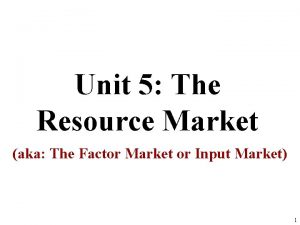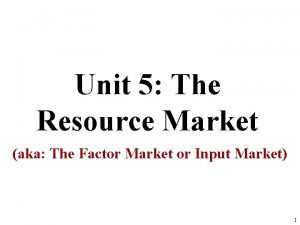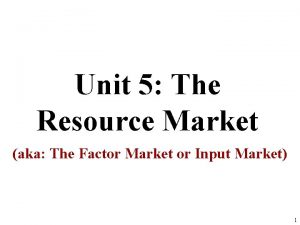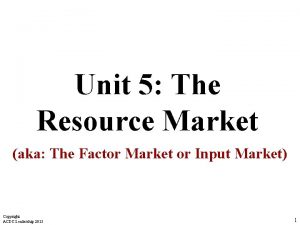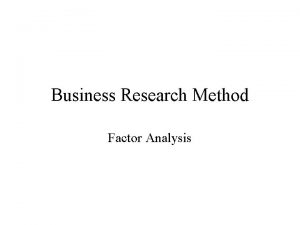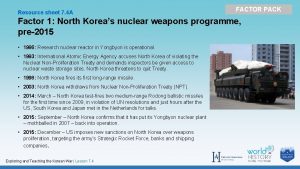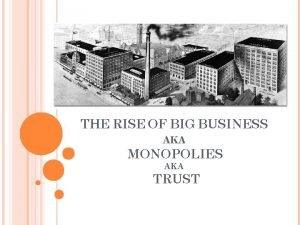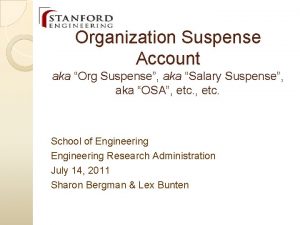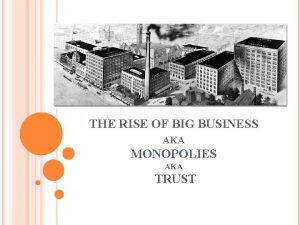Unit 5 Resource Market aka The Factor Market


























- Slides: 26

Unit 5 Resource Market (aka: The Factor Market or Input Market) 1

Review 1. Give an example of Derived Demand. 2. Define MRP. 3. Explain the difference between MRP and MR. 4. Why does the MRP fall as more workers are hired? 5. Identify the two ways to calculate MRP. 6. Define MRC. 7. Explain the difference between MRC and MC. 8. How does a firm decide how many workers to hire? 9. Name two birds with echolocation. 2

Why do people with only high school degrees make less money on average? Employers assume they have low productivity and will generate less additional revenue. 3

Does having an education mean that you will automatically have a higher income? 4

Real Life Application Top 5 Fastest Growing Jobs (2000 -2010) 1. Computer Software Engineers, Applications 2. Computer Support Specialists 3. Computer Software Engineers, Systems 4. Computer Systems Administrators 5. Data Communications Analyst Top 5 Fastest Declining Jobs 1. Railroad Switch Operators 2. Shoe Machine Operators 3. Telephone Operators 4. Radio Mechanics 5. Loan Interviewers WHY & NOW WHAT? “You’ve got to learn computers!” 5

Real Life Application Ten most profitable majors and the average starting salary (Aug, 2013): 1. Petroleum engineering $98, 000 2. Chemical engineering $67, 500 3. Nuclear engineering $66, 800 4. Electrical engineering $63, 400 5. Computer engineering $62, 700 6. Aerospace engineering $62, 500 7. Mechanical engineering $60, 100 8. Materials science & engineering $60, 100 9. Industrial engineering $59, 900 10. Computer science $58, 400 6

Video: Did You Know? 7

MRP (SL) = MRC (DL) 8

Last Class Activity Wage = $20 / Price = $10 Units of Labor Total Product (Output) Marginal Product (MP) Product Price Marginal Revenue Product (MRP) 0 1 2 3 4 5 6 7 0 7 17 24 27 29 30 27 7 10 7 3 2 1 -3 0 10 10 0 70 100 70 30 20 10 -30 Shows how many workers a firm is willing and able to hire at different wages. 9

Last Class Activity Wage = $20 / Price = $10 Units of Labor Total Product (Output) Marginal Product (MP) Product Price Marginal Revenue Product (MRP) 0 1 2 3 4 5 6 7 0 7 17 24 27 29 30 27 7 10 7 3 2 1 -3 0 10 10 0 70 100 70 30 20 10 -30 Demand for this resource Plotting the MRP/Demand curve 10

Drawing the Demand Curve for Resources 11

Demand=MRP Wage Why is it downward sloping? Because of the law of DIMINISHING MARGINAL RETURNS $100 80 Each additional resource is less productive and therefore is worth less than the previous one 60 40 This model applies to LAND, LABOR, & CAPITAL 20 1 2 3 4 5 6 Dl=MRP QL 7 8 Quantity of Workers 12

What happens if DEMAND for the product INCREASES? Wage $100 MRP increases causing demand to shift right 80 In other words, 60 MRP represents the value of each worker. 40 20 1 2 3 4 5 6 Dl’=MRP’ Dl=MRP QL 7 8 Quantity of Workers 13

Shifting the Demand Curve for Resources 14

Resource Demand Shifters 1. ) Changes in the Demand for the Product üPrice increase of the product increases MRP and demand for the resource. 2. ) Changes in Productivity üTechnological Advances increase Marginal Product and therefore MRP/Demand. 3. ) Changes in Price of Related Resources üSubstitute Resources Ø Ex: What happens to the demand for assembly line workers if price of robots falls? üComplementary Resources Ø Ex: What happens to the demand of nails if the price of lumber increases significantly? 15

3 Shifters of Resource Demand Identify the Resource and Shifter (ceteris paribus): 1. Increase in demand for microprocessors leads to a(n) ____ in the demand for processor assemblers. 2. Increase in the price for plastic piping causes the demand for copper piping to _____. 3. Increase in demand for small homes (compared to big homes) leads to a(n) _____ the demand for lumber. 4. For shipping companies, _____ in price of trains leads to decrease in demand for trucks. 5. Decrease in price of sugar leads to a(n) _____ in the demand for aluminum for soda producers. 6. Substantial increase in education and training leads to an ______ in demand for skilled labor. 16

3 Shifters of Resource Demand Identify the Resource and Shifter (ceteris paribus): 1. Increase in demand for microprocessors leads to a(n) ____ increase in the demand for processor assemblers. 2. Increase in the price for plastic piping causes the demand for copper piping to _____. increase 3. Increase in demand for small homes (compared to big decrease the demand for lumber. homes) leads to a(n) _____ 4. For shipping companies, _____ decrease in price of trains leads to decrease in demand for trucks. 5. Decrease in price of sugar leads to a(n) _____ in increase the demand for aluminum for soda producers. 6. Substantial increase in education and training leads to an ______ increase in demand for skilled labor. 17

Use the following data: Price Units of Labor Total Product (Output) 0 1 2 3 4 0 7 17 24 27 = $10 Wage = $20 Marginal Product Price (MP) 7 10 7 3 0 10 10 Marginal Revenue Product Marginal Resource Cost 0 70 100 70 30 0 20 20 How would this change if the DEMAND for the good INCREASED significantly? 1. Price of the good would increase. 2. Value of each worker would increase. 19

Use the following data: Price = $100 Wage = $20 Units of Labor Total Product (Output) Marginal Product (MP) 0 1 2 3 4 5 6 7 0 7 17 24 27 29 30 27 7 10 7 3 2 1 -3 Product Price Marginal Revenue Product 0 0 0 10 100 700 10 1000 10 100 700 10 100 300 10 100 200 10 100 -300 Marginal Resource Cost Each worker is worth 10 X more THIS IS DERIVED DEMAND. 20

Use the following data: Price Units of Labor Total Product (Output) 0 1 2 3 4 0 7 17 24 27 = $10 Wage = $20 Marginal Product Price (MP) 7 10 7 3 0 10 10 Marginal Revenue Product Marginal Resource Cost 0 70 100 70 30 0 20 20 How would change if the PRODUCTIVITY of each worker INCREASED? 1. Marginal Product would increase. 2. Value of each worker would increase. 21

Use the following data: Price = $10 Wage = $20 Units of Labor 0 1 2 3 4 5 6 7 Total Product (Output) Marginal Product Price (MP) 0 0 7 70 70 17 170 100 24 240 70 27 270 30 29 290 20 30 300 10 27 270 -30 0 10 10 Marginal Revenue Product 0 700 Each worker is worth 1000 more! 700 300 More 200 demand for resource. 100 -300 22

Shifting the Supply Curve for Resources 23

Resource Supply Shifters for Labor 1. Number of qualified workers Education, training, & abilities required 2. Government regulation/licensing What if waiters had to obtain a license to serve food? 3. Personal values regarding leisure time and societal roles. Why did the US Labor supply increase during WWII? Why do some occupations get paid more than others?

Use supply and demand analysis to explain why surgeons earn an average salary of $137, 050 & gardeners earn an average salary of $13, 560. Supply and Demand For Gardeners Wage Rate Supply and Demand For Surgeons SL DL Quantity of Workers

What are other reasons for differences in wage? Labor Market Imperfections- Ø Insufficient/misleading job informationØ This prevents workers from seeking better employment. Ø Geographical ImmobilityØ Many people are reluctant or too poor to move so they accept a lower wage Ø Unions Ø Collective bargaining and threats to strike often lead to higher than equilibrium wages Ø Wage DiscriminationØ Some people get paid differently for doing the same job based on race or gender. (VERY ILLEGAL)

“Glass Ceilings”
 Resource factor market
Resource factor market Unit 5 the resource market
Unit 5 the resource market Resource allocation vs resource leveling
Resource allocation vs resource leveling Contoh resource loading
Contoh resource loading Market leader challenger follower nicher
Market leader challenger follower nicher Define market segmentation targeting and positioning
Define market segmentation targeting and positioning Unit 6 review questions
Unit 6 review questions Gcf of expressions
Gcf of expressions Factoring greatest common factor
Factoring greatest common factor Form factor formula
Form factor formula Example of situation producing questions
Example of situation producing questions Factor gcf
Factor gcf Common factors of 36 and 48
Common factors of 36 and 48 Hát kết hợp bộ gõ cơ thể
Hát kết hợp bộ gõ cơ thể Frameset trong html5
Frameset trong html5 Bổ thể
Bổ thể Tỉ lệ cơ thể trẻ em
Tỉ lệ cơ thể trẻ em Chó sói
Chó sói Glasgow thang điểm
Glasgow thang điểm Hát lên người ơi
Hát lên người ơi Môn thể thao bắt đầu bằng chữ đua
Môn thể thao bắt đầu bằng chữ đua Thế nào là hệ số cao nhất
Thế nào là hệ số cao nhất Các châu lục và đại dương trên thế giới
Các châu lục và đại dương trên thế giới Công của trọng lực
Công của trọng lực Trời xanh đây là của chúng ta thể thơ
Trời xanh đây là của chúng ta thể thơ Mật thư anh em như thể tay chân
Mật thư anh em như thể tay chân Phép trừ bù
Phép trừ bù







